Physisorption
Physisorption
Physical adsorption is a system used to portray the surface and pore features of solids, that is, the surface of the material. The adsorption isotherm produced by the Physical Adsorption procedure enables one to portray a solids' surface by deciding its surface area, porosity, and complete pore volume.
It is the physical bonding of gas molecules to the surface of a solid or fluid that the gas comes into interaction with at low temperatures. It happens because of Van der Waals forces. The weak bonding is not surface-specific and takes place between all gas molecules on any surface. The process, which does not include any surface reaction, is accomplished rapidly at low temperatures. However, surface inclusion reduces with a rise in temperature. Physisorption is used when evaluating the total surface area and in pore size analysis of mesopores, micropores and nanopores.
What is Adsorption?
It is the adherence of molecular agents onto a particular surface. It is different from absorption, which is a physical or chemical phenomenon wherein atoms, molecules or ions enter some mass phase.
Surface area and porosity are significant physical properties that impact the quality, utility, and treatment of numerous materials, which frequently must be painstakingly built to perform particular functions. Disparities in the surface area and porosity of material which otherwise may have the same physical dimensions can significantly impact its performance characteristics.
Subsequently, it is basically significant that these characteristics be accurately determined and controlled.
Reason behind the occurrence of Physisorption
Physisorption occurs due to the intermolecular force that exists among adsorbates and adsorbents. The adsorption is referred to as van der Waals adsorption and the molecular force is called van der Waals force. As the van der Waals force exists between any two molecules, physical adsorption can happen on any solid surface. Since physisorption happens due to intermolecular forces, the binding force is feeble with less heat of adsorption, and the rate of adsorption and desorption is fast. The adsorbed substance is easier to desorb. Thus the physical adsorption is reversible partly. For instance, adsorbed gas on initiated carbon is easily removed with no changes in nature.
Understanding Physical adsorption
Several atoms that constitute a solid are bordered by different atoms on all sides. Atoms on the solid's surfaces are not bounded totally. Van Der Waals molecular interactions cause these surface atoms to be reactive, causing them to draw in liquids, vapours and gases so as to satisfy their inter-molecular force imbalance. The pulled in molecules fill in the pores on the surface of the solid when adsorption occurs.
This adherence of gas or fluid molecules to the surface of a solid does not influence the molecule's electronic and geometrical characteristics. However, a slight yet reversible deformation of the atoms may happen. There is no chemical affinity or specificity in physisorption. Any gas can be adsorbed on any solid surface if the given low temperature or high-pressure conditions are met.
The adherence molecules (adsorbate) are not restricted to gases as a source and can be from liquids or solids. The physical adsorption of gas molecules occurs on both solid and fluid surfaces (adsorbents). Fluid molecules can also hold fast to solid surfaces, and solid-to-solid adherence also occurs.
The physisorption impact is used in deciding surface areas and the porosity of solid surfaces. The surface area decided using this analysis is progressively intricate, yet an actual measurement, as opposed to the area controlled by the width and length of an item. The analysis takes into account all the different areas because of ripples, pores and different imperfections.
Related Videos:
- Differences between physisorption and chemisorption
- One similarity between physisorption and chemisorption
- Define adsorption and write two important differences between physical adsorption and chemisorption
Difference Between Physical Adsorption and Chemical Adsorption
A unique characteristic of a solid substance is a scattering of weak surface energy sites. Gas or fume molecules can get bound to these sites. This, by and large, describes the adsorption phenomenon.
The amount of molecules adsorbed by the surface depends on several conditions and features, including pressure, temperature, surface energy distribution, and the surface area of the solid substance. A graph of the number of molecules adsorbed versus pressure at constant temperature is known as the adsorption isotherm.
Physical adsorption ("physisorption") is the result of moderately weak Van der Waal's molecular interaction forces between the surface of the solid material and the adsorbate - a physical attraction. Physical adsorption is easily reversed. Based on the gas and solid surface, the adsorption can result in the sharing of electrons between the adsorbate and the solid surface. i.e., a chemical bond. This is chemical adsorption and not at all like physisorption; chemisorption is hard to reverse. A significant amount of energy usually is required to evacuate chemically adsorbed molecules. Physical adsorption takes place on all surfaces gave that temperature
Chemisorption, nonetheless, occurs just between specific adsorbents and adsorptive species and just if the surface is cleaned of previously adsorbed molecules. Under appropriate conditions, physical adsorption can result in adsorbed molecules forming numerous layers. Chemisorption, then again, just proceeds as long as the adsorptive can reach the surface; it is typically considered to be a single-layer process.
A feature of physical adsorption is that almost all the adsorbed molecules can be expelled by evacuation at the same temperature at which the adsorption happened. Warming accelerates desorption because it makes promptly accessible to the adsorbed molecules the energy necessary to escape the adsorption site. A chemically adsorbed particle is strongly bound to the surface and can't escape without the convergence of a generally huge amount of energy contrasted with that necessary to liberate a physically bound atom. This energy is given by heat, and frequently extremely high temperatures are needed to get rid of chemically adsorbed molecules.
Physisorption tends to happen just at temperatures close or underneath the boiling point of the adsorptive at the common pressure. This is not the situation with chemisorption. Chemisorption usually can occur at temperatures well over the boiling point of the adsorptive.
Applications of Physisorption
Physisorption analysis is generally used in research, advancement and quality control in industries such as:
• Nanotechnology
• Metallurgy
• Pharmaceutical
• Material science
Important Chapters:
Similar Questions
Which of the following statements is not true?
a. Both physisorption and chemisorption are exothermic.
b. Physisorption occurs with increase of free energy.
c. Physisorption requires low activation energy but chemisorption requires high activation energy.
d. The magnitude of chemisorption increases and that of physisorption decreases with rise in temperature.View SolutionIn a particular case of physisorption, magnitude of enthalpy change and entropy change were observed to be 28 kJ/mole and 100 J/mole-K. Calculate the minimum temperature (in .∘C) above which physisorption will become non spontaneous.
View Solution
Knowledge Check
- Question 1 - Select One
The amount of gas adsorbed (x/m) is the function of temperature and pressure, which can be shown as under
xm= f(p,T)
The variation x/m and p, at constant temperature is known as adsorption isotherm
i.e., x/m=f(p) at constant temperature
Seven type of physisorption isotherms are known. Some of them are shown below
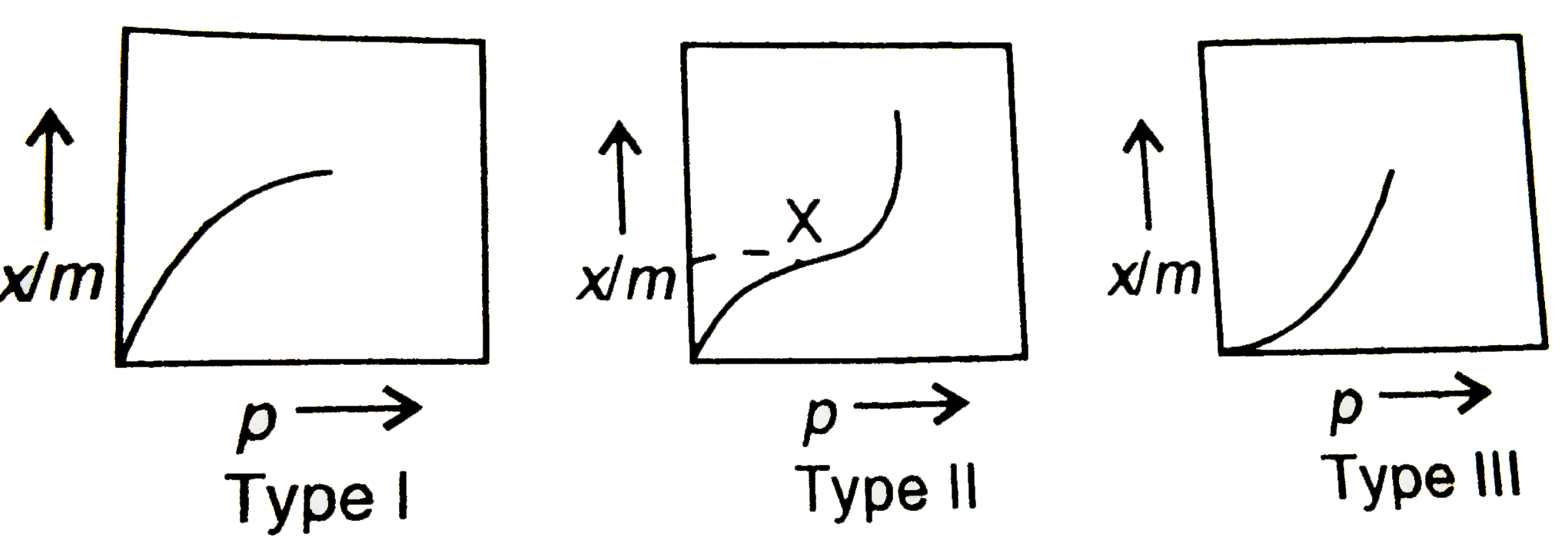
Physisorption Type I. Where there is formation of monolayer on the surface of adsorbent, this type of curve is obtained.
Physisorption Type II. The transition point 'X' of this physisorption isotherm indicates, that the formation of mono layer is complete and that of multilayer is started.
Physisorption Type III. This isotherm has no transition point. In this type of curve, the multimolecular starts before the completion of monomolecular layer.
On the basis of this comprehension, answer teh following question from the physisorption isotherm of a gas on a solid shown as under.
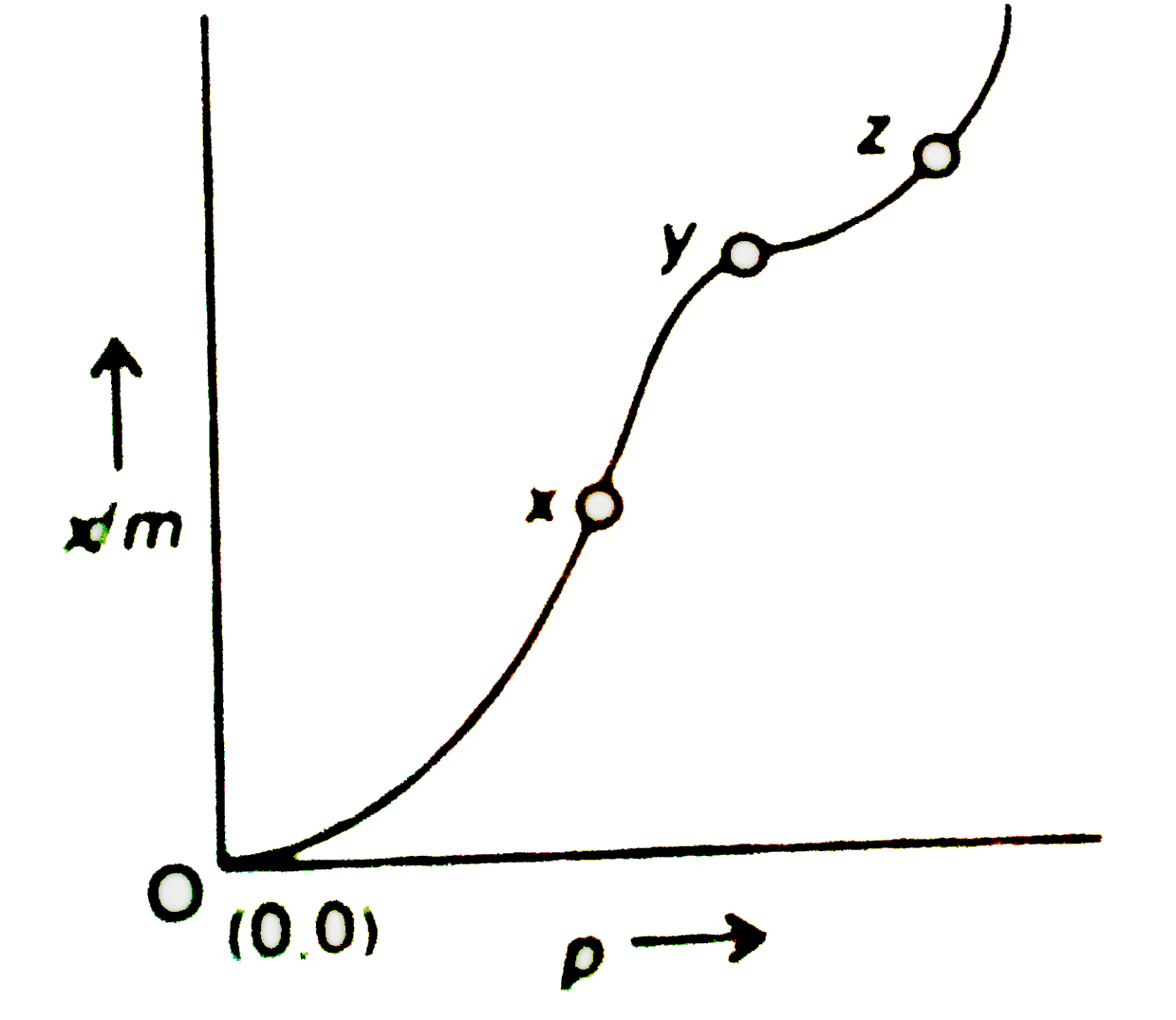
The point Y of physisorption isotherm correctly representsAformation of monolayerBformation of multilayerCfirst monolayer formation thereafter the formation of multilayerDnone - Question 2 - Select One
The amount of gas adsorbed (x/m) is the function of temperature and pressure, which can be shown as under
xm= f(p,T)
The variation x/m and p, at constant temperature is known as adsorption isotherm
i.e., x/m=f(p) at constant temperature
Seven type of physisorption isotherms are known. Some of them are shown below

Physisorption Type I. Where there is formation of monolayer on the surface of adsorbent, this type of curve is obtained.
Physisorption Type II. The transition point 'X' of this physisorption isotherm indicates, that the formation of mono layer is complete and that of multilayer is started.
Physisorption Type III. This isotherm has no transition point. In this type of curve, the multimolecular starts before the completion of monomolecular layer.
On the basis of this comprehension, answer teh following question from the physisorption isotherm of a gas on a solid shown as under.
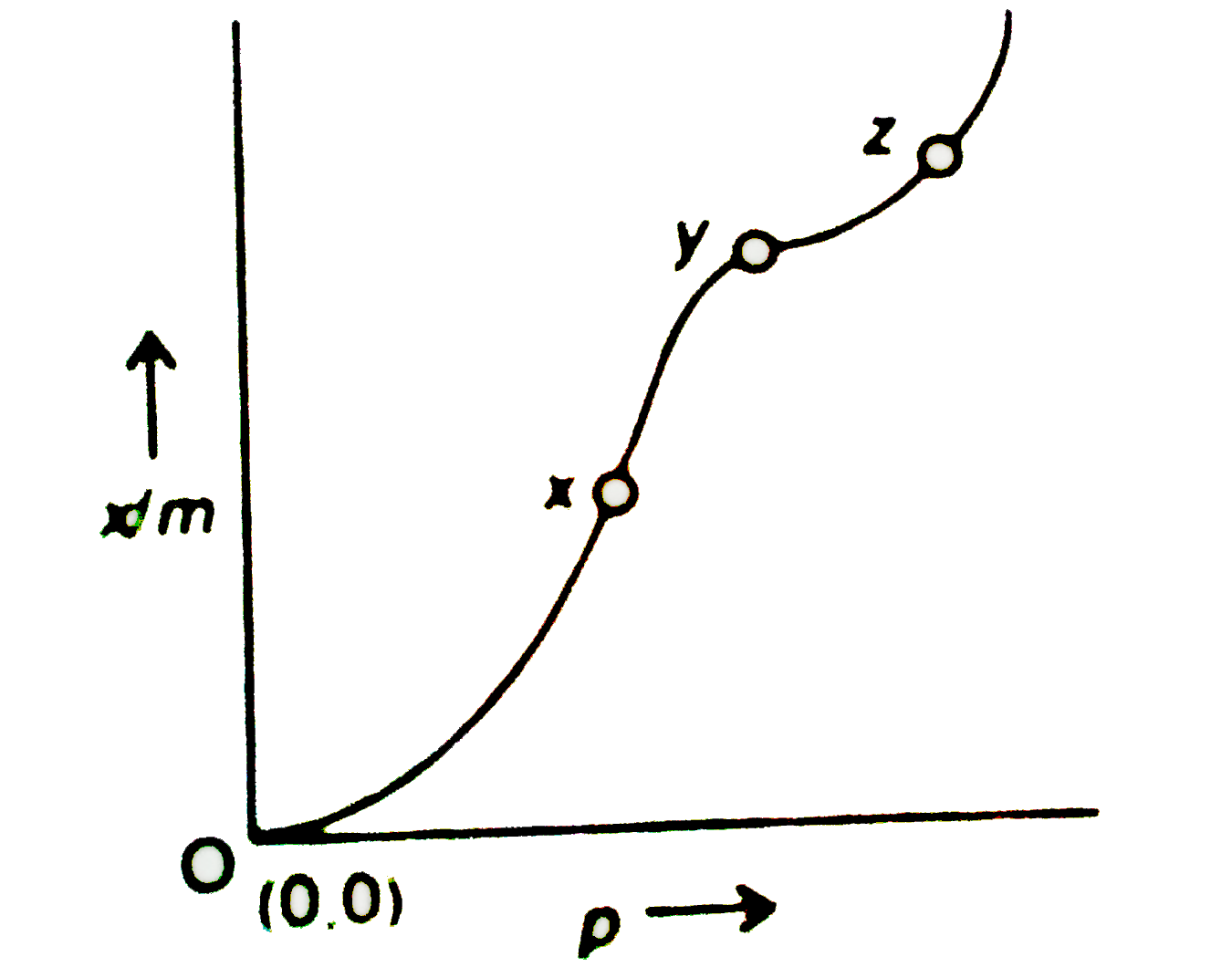
The point Z of the physisorption correctly representsAJust beginning of formation of multilayerBJust beginning of formation of monolyerCJust completion of multilayer and just formation of monolyerDxm∝pn where n > 1 - Question 3 - Select One
The amount of gas adsorbed (x/m) is the function of temperature and pressure, which can be shown as under
xm= f(p,T)
The variation x/m and p, at constant temperature is known as adsorption isotherm
i.e., x/m=f(p) at constant temperature
Seven type of physisorption isotherms are known. Some of them are shown below

Physisorption Type I. Where there is formation of monolayer on the surface of adsorbent, this type of curve is obtained.
Physisorption Type II. The transition point 'X' of this physisorption isotherm indicates, that the formation of mono layer is complete and that of multilayer is started.
Physisorption Type III. This isotherm has no transition point. In this type of curve, the multimolecular starts before the completion of monomolecular layer.
On the basis of this comprehension, answer teh following question from the physisorption isotherm of a gas on a solid shown as under.
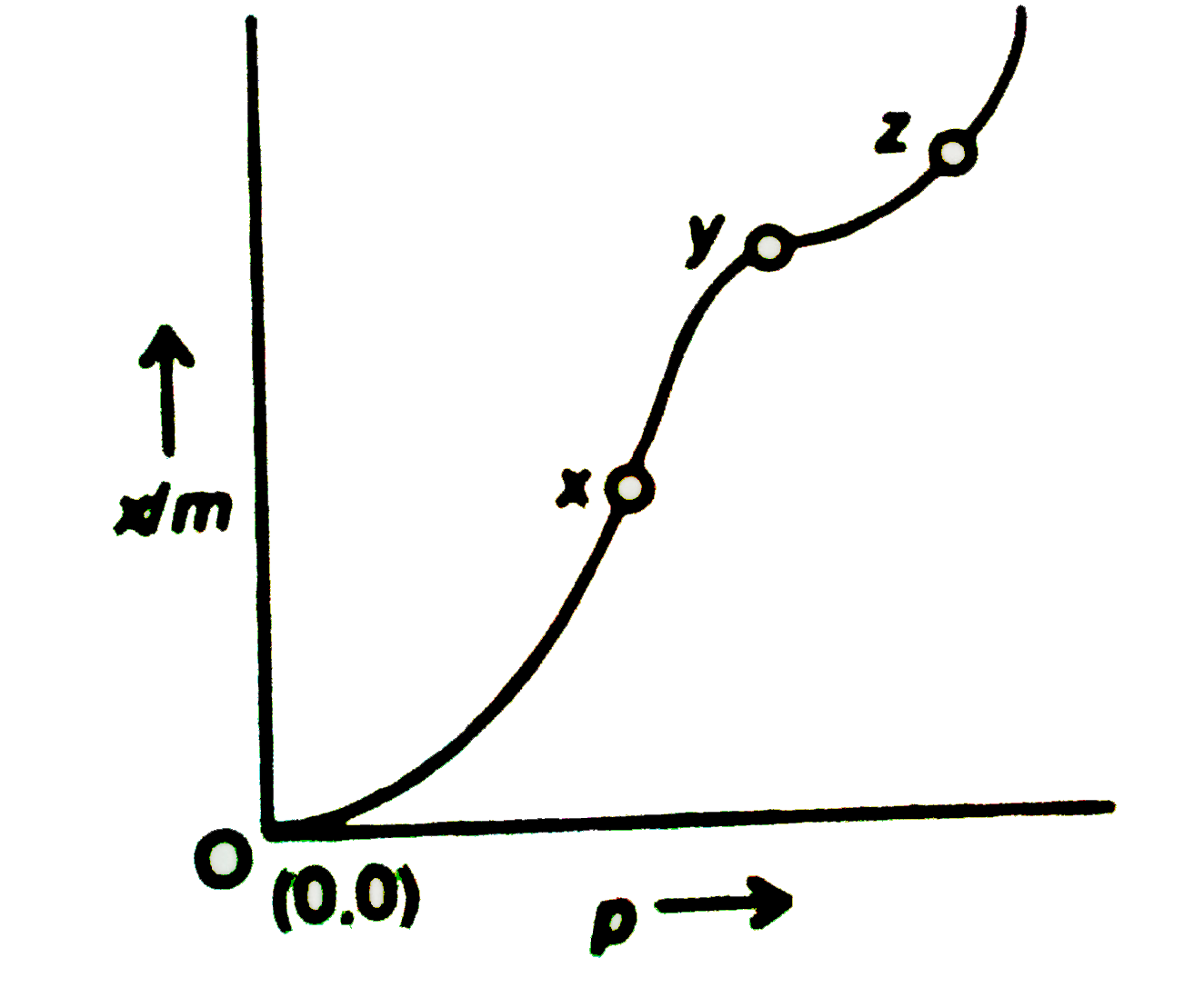
The portion ''OX'' of the physisorption isotherm representsAx/m is directly proportional to pBx/m is linear function of pressureCadsorption isotherm has no transition point, the formation of multi-molecular layer starts before the completion of monomolecular layerDBoth B and C
Giving appropriate examples, explain how the types of processes of adsorption (physisorption and chemisorption) are influenced by the prevailing temperature , the surface area of adsorbent and the activation energy of the process?
View SolutionThe amount of gas adsorbed (x/m) is the function of temperature and pressure, which can be shown as under
xm= f(p,T)
The variation x/m and p, at constant temperature is known as adsorption isotherm
i.e., x/m=f(p) at constant temperature
Seven type of physisorption isotherms are known. Some of them are shown below

Physisorption Type I. Where there is formation of monolayer on the surface of adsorbent, this type of curve is obtained.
Physisorption Type II. The transition point 'X' of this physisorption isotherm indicates, that the formation of mono layer is complete and that of multilayer is started.
Physisorption Type III. This isotherm has no transition point. In this type of curve, the multimolecular starts before the completion of monomolecular layer.
On the basis of this comprehension, answer teh following question from the physisorption isotherm of a gas on a solid shown as under.
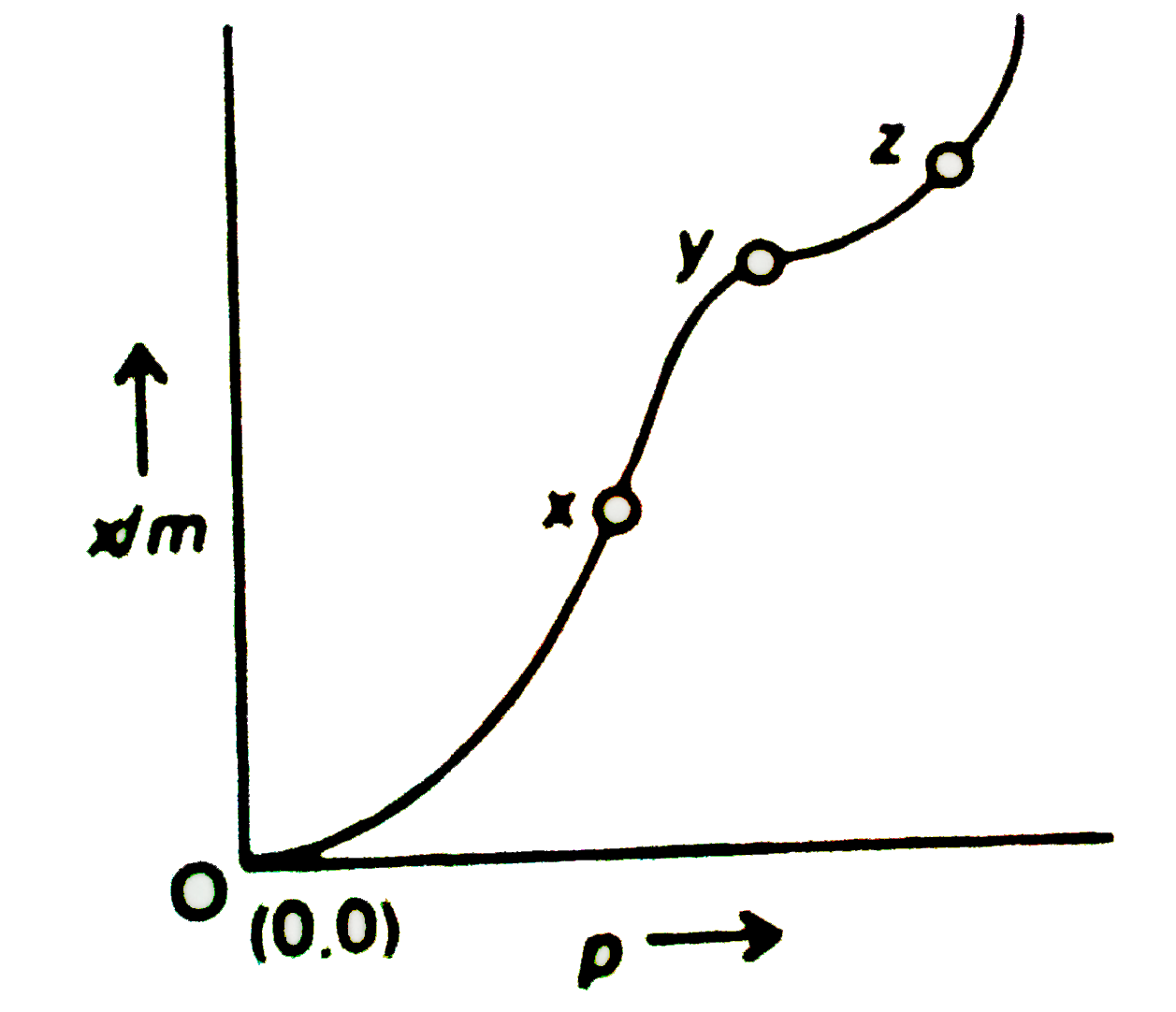
The portion XY of the curve correctly representsView SolutionThe correct statements pertaining to the adsorption of a gas on a solid surface are
(i) Adsorption is always exothermic
(ii) Physisorption may transform into chemisorption at high temperature
(iii) Physisorption increases with increasing temperature but chemisorotion decrease with increasing temperature
(iv) Chemisorption is more exothermic than physisoption, however, it is very slow due to higher energy of activationView SolutionThe correct statement(s) pertaining to the adsorption of a gas on a solid surface is(are)
(i) adsorption is always exothermic
(ii) physisorption may transform into chemsisorption transform into chemisorption at high temperature
(iii) physisorption increases with increasing temperature but chemisorption decreases with increasing temperature .
(iv) chemisorption is more exothermic than physisorption , however it is very slow due to higher energy of activation.View Solution

